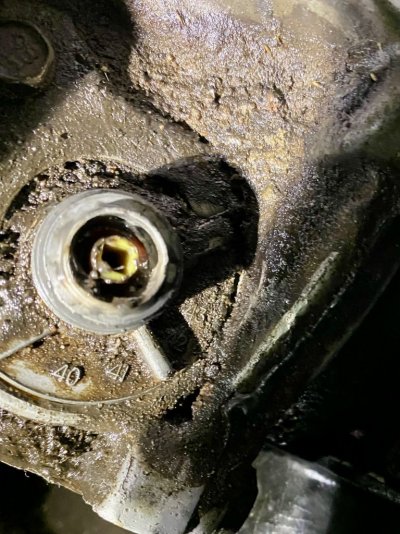Thanks for posting this thread and the associated links! I'm not inclined to work on transmissions much myself, but want to know what I can so I can have an intelligent conversation with the shop when I have them rebuilt.
Recently I started having issues with a TH-400 in my 78 Chevy C20. After sitting for an extended period it would act as if it was low on fluid, not engaging Drive or Reverse when selected. After what seemed like an eternity (probably 15 to 20 minutes) it would start to react and eventually behave normally. I moved it from the house I'm renovating to the house I'm living in (about 5 miles) and it sat while I replaced the rear springs and shocks (another extended time). While it was off the road, I replaced the transmission filter and installed a "deep" pan with a drain plug. The fluid that came out was not dark or have any burnt smell to it, so I thought that was a good sign. I used the chart in a factory service manual to get me started on the fluid replacement, and when I tried to get the truck to move it did a lot of the same thing. Eventually I added more fluid slowly and kept checking the dipstick until it started to move on its own -- I started to wonder if the dipstick is the wrong one for the truck, as I never saw the level show up on it. Took it out on the street and it seemed to run fine -- because of the broken rear spring I had never put it on the highway, so once I was assured it was OK I took it out and even at highway speeds it seemed OK.
Fast forward to just before I had my knee replacement. The truck was back at the house I'm renovating, and it started to act the same way again. Fluid level seems to be OK, but won't move and acts like it's low on fluid. I'm going to have to have someone work on it as I'm still not 100% from the replacement.
Two questions: 1, are there different dipstick lengths on TH-400s (I don't think this transmission is the original); and 2, what is the difference in depth between the "shallow" and "deep" factory pan? When I sat the replacement pan next to the pan off of the truck they appeared to be the same depth.
Because I'm an oddball my 1985 GMC project is going to have an Olds small-block in it with a switch-pitch TH-400, I bought that transmission and have it in storage along with a redesigned controller for the TC function. 25-plus years ago I scored a couple of finned cast aluminum pans for TH-400s, one of those will be added to the GMC transmission along with an external cooler and fan so I can tow without issues. Thanks again for the post!
Take Care,
KS in KCK
Yes, there are for sure different dipsticks. Not sure how many, there are many though since they're intended for many different model cars, trucks, vans, RV's etc
There is a deep pan and a shallow pan, and the difference is very obvious. One is I'd say an inch deepl the other usually found on trucks is close to 3 inches deep. So if yours that you compared looked the same, then they are the same.
Awesome for you and the variable pitch Th400. I had a VP Th400 out of a 67 Olds that was behind an Olds 425. I wanted to use it too just for the cool factor of having 2 different stall speeds. I wanted to make a street/strip truck and use a toggle switch for close to stock stall, and hit the switch and go into about a 3000 stall. Well, as many awesome awesome projects and opportunities I've had with cool parts, that I had to sell to make ends meet, those parts got sold on eBay for about 5 times what I paid for them, not to mention all the other spare parts I had too. But yeah, get that done and let us know how it goes. I had trouble finding someone that build my converter the way I wanted it built and I knew it would be expensive if I did find someone, so that was part of the decision in selling the parts to someone who may have already had the converter they wanted.
What is sittting for an extended period? You know an older transmission that sits for several months or years will tend to harden the seals in the clutch drums and such and it won't move. After warming up a bit, you might get a little action out of it as the seals soften just a bit. If that's the case, I've had some real good luck in the past by adding a trans additive. I know I know, I too had additives to anything, engine, trans, anything, but I have to say, it's been more than once or twice where I've seen additives help an auto trans that sat for quite some time. The additives seem to soften the seals and make them a bit more supple and pliable to where the transmission will work again. I'll also add, if it does work out, don't have high expectation for a long lived transmission. But hopefully, it'll be patch job to get you by for a couple to a few months to when it's a better time to get a rebuild done. You can add 1 bottle and see what happens. If it's needs 1 more, go for it. If 2 bottles don't do it, then give it up, it's not going to work this time.


